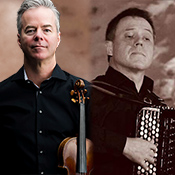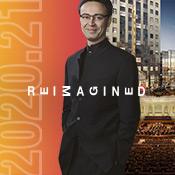
Tōru Takemitsu: Experiencing Nature in Music
Paul Kosidowski
PUBLISHED
Tagged Under: 2020.21 Season, Classics
Even if you’re not familiar with the name Tōru Takemitsu, you’ve probably heard his music in a movie theater. It creates a mood of bleak fate under the violent battle scenes of Akira Kurosawa’s Ran; it charges the propulsive action scenes of Philip Kaufmann’s thriller Rising Sun; and it sets the somber, meditative tone of Shohei Imamura’s Black Rain.
That’s how MSO Music Director Ken-David Masur first discovered Takemitsu—through his film scores. Today, speaking by phone between meetings and rehearsals, he calls him the John Williams of Japanese film. Three of his works will be featured in the Milwaukee Symphony Orchestra’s concert program, “Celebrating Takemitsu,” available on MSO Live on April 17.
But there is much more to the man who some call the greatest Japanese composer of the 20th century. “The film music was only one side of him,” says Masur. “He was like Shostakovich in Russia, everywhere on the music scene—symphonies, chamber music, film scores. His influences included everything from jazz to pop to rock.”
That eclecticism is apparent in his library of film scores, but Takemitsu’s music for the concert hall owes much to the French composers Claude Debussy and Olivier Messiaen. Those two composers, says Masur, were central to Takemitsu’s musical philosophy: “of how he sees the world and hears the world and experiences the world.”
In particular, Takemitsu, who died in 1996, was interested in capturing the spirit and spirituality of nature. For Masur, this is part of Takemitsu’s Japanese identity. “I can only speak for how I experienced it growing up,” he explains. “There’s a different sense of spirituality and nature. The spirit roams within every object in nature—stones, trees, water.”
That’s nothing new to Western classical music, of course. Debussy captured the feeling of the roiling sea in La Mer, and Messiaen brought the melodies of birdsong into the concert hall. Even before the 20th century, Beethoven’s long walks in the forests surrounding Vienna inspired works like the “Pastoral” Symphony, and Handel took his audience to the river Thames in his Water Music.
But Takemitsu captures nature in a distinctly modern way. “In 18th– and 19th-century music you have dissonance and resolution,” explains Masur. “You start somewhere that is familiar, you venture out into a dissonance or a different key, and then you return.” The music begins, takes a journey, and then goes home. Even in the more atmospheric “sound world” of Debussy and Messiaen, there is a sense of beginning and ending.
But Takemitsu’s music is different. “These pieces don’t give us the beginning of a story and then the end of a story,” he explains. “Instead, it’s as if we are entering into something that has been moving for thousands of years. It’s a feeling of time and space flowing—as if we happen upon a world that has been going on eternally.”
Moreover, Takemitsu’s instrumentation and harmony creates an otherworldly, but very human, experience. “He manages that with the atmospheres he creates with amazing colors and combinations of instruments,” Masur says. “We don’t hear specific instruments as much as we hear reflections of our internal nervous systems as it tries to relate to the mystery of the world.”
Takemitsu liked to refer to the music behind this atmosphere as a “sea of tonality,” a term which he started to use in the later part of his career. When he first started composing, World War II still cast a shadow on Japan, and Takemitsu rejected aspects of Japanese culture because of its association with the country’s militarism. But he eventually embraced Japanese aesthetics, partly through his friendship with the composer John Cage, who he met in 1964. “Cage reminded him of the spirituality rooted in Asia and Japan,” Masur says. “And to see a Westerner embracing part of his heritage, that started a period where he wanted to reconcile those two cultures.”
Two pieces on the April 17th program, “Tree Line” and “Rain Coming,” are good examples of the composer’s embrace of Japanese aesthetics – part of Takemitsu’s “Waterscape Cycle,” completed in the early 1980s. “Tree Line” is inspired by a row of Acacia trees along a road that the composer often walked. “Rain Coming” is evocative of the moments before a storm.
“When I see and listen to flowing water,” Takemitsu wrote about an earlier composition, “it reminds me of an old Japanese word, Tao (the Path)… My image of Tao is not a continuous road but many disconnected dots. Listeners will experience a feeling of stillness, motion, time, and space. These spaces and times are not the same as physics. They are rhythm of nature and time of mind.”
These ideas really connect with Masur’s love of Takemitsu. In pieces like these, he says, Takemitsu captures the independence and spontaneity of water and rain. “He’s able to give us a sound world that is suggestive, that really plays to our imagination. He takes us on a journey as we listen. It’s for all of us, but it’s also very personal. To me, that’s the magic.”



